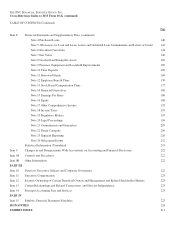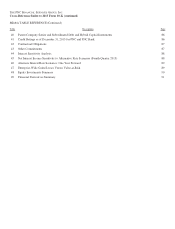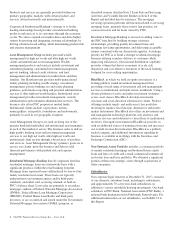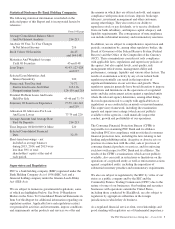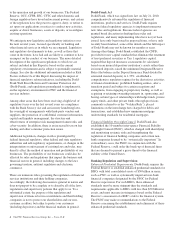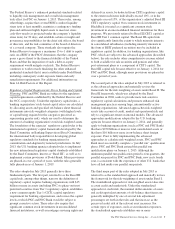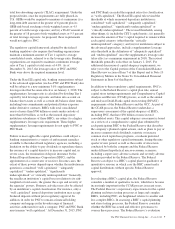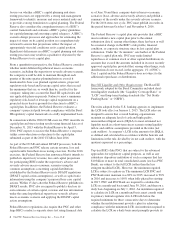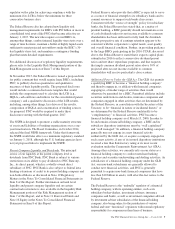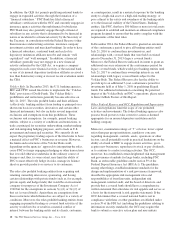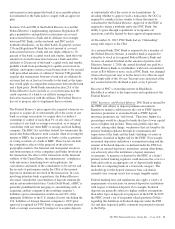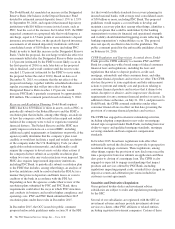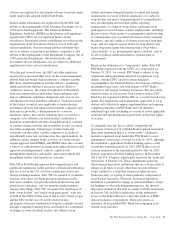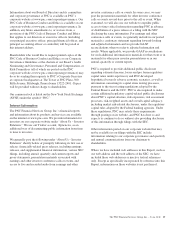PNC Bank 2015 Annual Report Download - page 23
Download and view the complete annual report
Please find page 23 of the 2015 PNC Bank annual report below. You can navigate through the pages in the report by either clicking on the pages listed below, or by using the keyword search tool below to find specific information within the annual report.
The Federal Reserve’s enhanced prudential standards related
to liquidity risk management and overall risk management
took effect for PNC on January 1, 2015. These rules, among
other things, require that covered BHCs conduct liquidity
stress tests at least monthly, maintain a contingency funding
plan and sufficient highly liquid assets to meet net stress
cash-flow needs (as projected under the company’s liquidity
stress tests) for 30 days, and establish certain oversight and
governance responsibilities for the chief risk officer, the board
of directors, and the risk committee of the board of directors
of a covered company. These standards also require the
Federal Reserve to impose a maximum 15-to-1 debt to equity
ratio on a BHC if the FSOC determines that the company
poses a grave threat to the financial stability of the United
States and that the imposition of such a debt-to-equity
requirement would mitigate such risk. The Federal Reserve
continues to work towards finalizing the other enhanced
prudential standards that it must establish under Dodd-Frank,
including counterparty credit exposure limits and early
remediation requirements. For additional information see
Item 1A Risk Factors of this Report.
Regulatory Capital Requirements, Stress Testing and Capital
Planning. PNC and PNC Bank are subject to the regulatory
capital requirements established by the Federal Reserve and
the OCC, respectively. Under the regulatory capital rules, a
banking organization’s risk-based capital ratios are calculated
by allocating assets and specified off-balance sheet financial
instruments into risk-weighted categories (with higher levels
of capital being required for the categories perceived as
representing greater risk), which are used to determine the
amount of a banking organization’s total risk-weighted assets.
The foundation of the agencies’ regulatory capital rules is the
international regulatory capital framework developed by the
Basel Committee on Banking Supervision (Basel Committee),
the international body responsible for developing global
regulatory standards for banking organizations for
consideration and adoption by national jurisdictions. In July
2013, the U.S. banking agencies adopted rules to implement
the new international regulatory capital standards established
by the Basel Committee, known as “Basel III”, as well as to
implement certain provisions of Dodd-Frank. Many provisions
are phased-in over a period of years, with the rules generally
fully phased-in as of January 1, 2019.
The rules adopted in July 2013 generally have three
fundamental parts. The first part, referred to as the Basel III
capital rule, among other things, narrows the definition of
regulatory capital, requires banking organizations with $15
billion or more in assets (including PNC) to phase-out trust
preferred securities from Tier 1 regulatory capital, establishes
a new common equity Tier 1 (CET1) capital regulatory
requirement for banking organizations, and revises the capital
levels at which PNC and PNC Bank would be subject to
prompt corrective action. These rules also require that
significant common stock investments in unconsolidated
financial institutions, as well as mortgage servicing rights and
deferred tax assets, be deducted from CET1 regulatory capital
to the extent such items individually exceed 10%, or in the
aggregate exceed 15%, of the organization’s adjusted Basel III
CET1 regulatory capital. Our common stock investment in
BlackRock is treated as a significant common stock
investment in an unconsolidated financial institution for these
purposes. We previously referred to Basel III CET1 capital as
Basel III Tier 1 common capital. The Basel III capital rule
also significantly limits the extent to which minority interests
in consolidated subsidiaries (including minority interests in
the form of REIT preferred securities) may be included in
regulatory capital. In addition, for banking organizations, like
PNC, which are subject to the advanced approaches (described
below), the rule includes other comprehensive income related
to both available for sale securities and pension and other
post-retirement plans as a component of CET1 capital. The
Basel III capital rule became effective on January 1, 2014 for
PNC and PNC Bank, although many provisions are phased-in
over a period of years.
The second part of the rules adopted in July 2013 is referred to
as the advanced approaches and materially revises the
framework for the risk-weighting of assets under Basel II. The
Basel II framework, which was adopted by the Basel
Committee in 2004, seeks to provide more risk-sensitive
regulatory capital calculations and promote enhanced risk
management practices among large, internationally active
banking organizations. Advanced approaches risk-weighted
assets take account of credit, market and operational risk and
rely to a significant extent on internal models. The advanced
approaches modifications adopted by the U.S. banking
agencies became effective on January 1, 2014, and generally
apply to banking organizations (such as PNC and PNC Bank)
that have $250 billion or more in total consolidated assets or
that have $10 billion or more in on-balance sheet foreign
exposure. Prior to fully implementing the advanced
approaches to calculate risk-weighted assets, PNC and PNC
Bank must successfully complete a “parallel run” qualification
phase. PNC and PNC Bank entered this parallel run
qualification phase on January 1, 2013. Although the
minimum parallel run qualification period is four quarters, the
parallel run period for PNC and PNC Bank, now in its fourth
year, is consistent with the experience of other U.S. banks that
have all had multi-year parallel run periods.
The third major part of the rules adopted in July 2013 is
referred to as the standardized approach and materially revises
the framework for the risk-weighting of assets under Basel I.
The standardized approach for risk-weighted assets takes into
account credit and market risk. Under the standardized
approach for credit risk, the nominal dollar amounts of assets
and credit equivalent amounts of off-balance sheet items are
generally multiplied by one of several risk adjustment
percentages set forth in the rules and that increase as the
perceived credit risk of the relevant asset increases. For
certain types of exposures, such as securitization exposures,
the standardized approach establishes one or more
The PNC Financial Services Group, Inc. – Form 10-K 5


